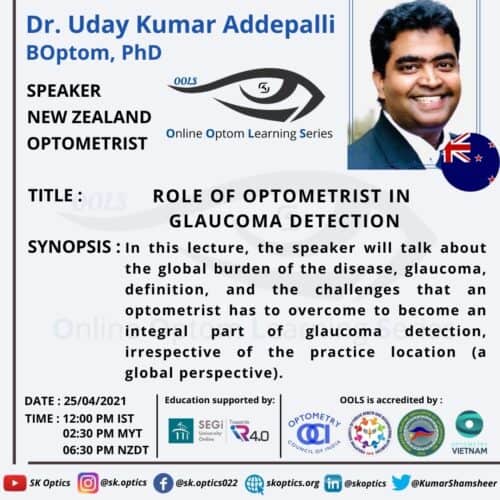
Dr. Uday Kumar Addepalli, a publich health optometrist and a researcher begins by explaining what is Glaucoma? He shortly mentions the prevalence of glaucoma and its different types. He also elaborates on the projected glaucoma prevalence for 2040.
Some of the common risk factors for glaucoma are age, genetics and high refractive errors. He briefly provides an overview of the how to suspect for glaucoma in a primary eye care clinic and how to diagnosis glaucoma with the right equipment.
Dr .Addepalli, enlist some of the skills required by optometrist to diagnose glaucoma.
Skills
- History taking
- Clinical examination
- Gonioscopy
- Fundus examination
- Grading of disc
Then, we learn about glaucoma disease stages and when and how it is possible to detect the disease. Some of the common challenges optometrist have to diagnosing glaucoma.
Challenges
- Training and Experience
- Individual motivation to expand the skill sets
- Improve skill sets to avoid false positives
- Develop referral pathway
- Type of practice
We learn about the scope of an optometrist in glaucoma detection and an overview of the importance of patient history, slitlamp examination, disc assessment, other necessary tests and diagnostic equipments.
Lastly, we discuss some interesting scenarios to learn about glaucoma diagnosis.
Scenario 1 Normal or Glaucomatous
Scenario 2 SDOCT
Scenario 3
Dr. Addepalli concludes the talk with describing a way forward for optometrist in glaucoma detection. He describes the success of specsavers model to integrate optometrist in glaucoma detection. The session ends with a question and answer session with the audience.
References
Papers
Tham YC, Li X, Wong TY, Quigley HA, Aung T, Cheng CY. Global prevalence of glaucoma and projections of glaucoma burden through 2040: a systematic review and meta-analysis. Ophthalmology. 2014 Nov;121(11):2081-90.
https://pubmed.ncbi.nlm.nih.gov/24974815/
Gibson T. Optometry’s role in managing patients with glaucoma. Clin Exp Optom. 2016 Jan;99(1):1-3.
https://pubmed.ncbi.nlm.nih.gov/26875848/
Weinreb RN, Khaw PT. Primary open-angle glaucoma. Lancet. 2004 May 22;363(9422):1711-20.
https://pubmed.ncbi.nlm.nih.gov/15158634/
Kumar AU, Jonnadula GB, Garudadri C, Rao HL, Senthil S, Papas EB, Sankaridurg P, Khanna RC. Agreement of glaucoma specialists and experienced optometrists in gonioscopy and optic disc evaluation. J Optom. 2013 Oct;6(4):212–8.
https://www.ncbi.nlm.nih.gov/pmc/articles/PMC3880447/
Gracitelli CP, Abe RY, Medeiros FA. Spectral-Domain Optical Coherence Tomography for Glaucoma Diagnosis. Open Ophthalmol J. 2015 May 15;9:68-77.
https://www.ncbi.nlm.nih.gov/pmc/articles/PMC4460228/
Addepalli UK, Jonnadula GB, Garudadri CS, Khanna RC, Papas EB. Prevalence of Primary Glaucoma as Diagnosed by Study Optometrists of L. V. Prasad eye Institute – Glaucoma Epidemiology and Molecular Genetics Study. Ophthalmic Epidemiol. 2019 Jun;26(3):150-154.
https://pubmed.ncbi.nlm.nih.gov/30489169/
Addepalli UK, Jonnadula GB, Garudadri CS, Rao HL, Rani PK, Chakrabarti S, Papas EB, Sankaridurg P, Khanna RC. LV Prasad Eye Institute Glaucoma Epidemiology and Molecular Genetic Study (LVPEI- GLEAMS). Report 1: study design and research methodology. Ophthalmic Epidemiol. 2013 Jun;20(3):188-95.
More Relatable Blogs:
- https://visionscienceacademy.org/evaluation-of-island-of-vision-relics-of-a-bygone-age/
- https://visionscienceacademy.org/optometrists-and-glaucoma/
- https://visionscienceacademy.org/ocular-response-analyzer/
- https://visionscienceacademy.org/change-of-ocular-dimensions-in-different-types-of-glaucoma/
- https://visionscienceacademy.org/24-2c-new-modality-of-visual-field-analyzer/
